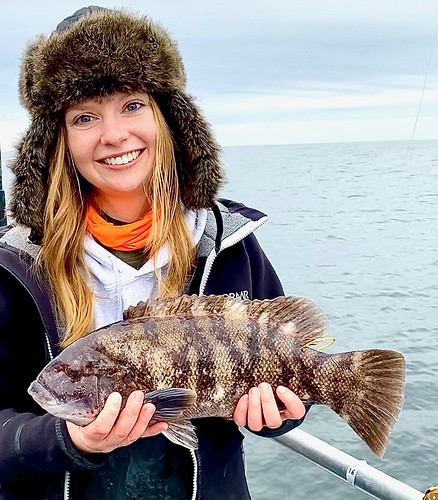
Photo by Monty Hawkins
Despite cold mid-winter weather, anglers across Maryland are enjoying fun fishing experiences ranging from the pre-season stockings of trout, to chain pickerel and blue catfish, to tautog in the offshore waters off our coast.
Forecast Summary: February:
With Bay temperatures in the upper 30s, Chesapeake Bay fish are in winter holding areas. With plenty of cool waters and oxygen from surface to bottom, look for concentrations of fish in some of the remaining warm water areas. In the main bay, warmer bottom waters deeper than 50 feet are located from the Bay Bridge south to near the Virginia State line, in areas with good structure and protection from strong current such as underwater points, channel edges, and bridge pilings with nearby oyster bottom and reefs. The other warm water areas to consider are near the water discharges of your local power plants.
We will begin our weekly fishing conditions forecasts again in March. However, for those hearty cold water anglers, all water conditions maps, plots, and satellite pics will be continuously updated and posted. So for detailed and up-to-date fishing conditions in your area of the bay, continue to check out Click Before You Cast. Get regular updates on Maryland’s waters sent to your inbox with our Eyes on the Bay newsletter. Sign up online.
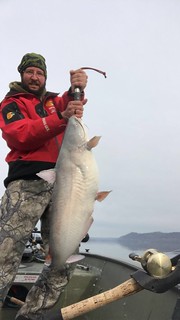
John McMullen holds up a big Susquehanna River blue cat. Photo by John McMullen
Upper Chesapeake Bay
At the far northern end of the Chesapeake Bay there is plenty of fishing action in the form of blue, flathead, and channel catfish at the Conowingo Dam pool, the lower Susquehanna River, and the surrounding area. The Chester River also has a good population of blue catfish from Chestertown up past Crumpton. Fishing from small boats or shorelines tends to be working well. Cut bait in the form of menhaden, gizzard shad, and clam snouts tend to be the most popular baits to use on a bottom rig for catfish. Bank fishing is one of the safer endeavors this time of the year. Water temperatures are in the 30s so be careful if you head out on open water, and wear that PFD.
There is a deep hole just downriver of the railroad bridge in the lower Susquehanna River where yellow perch congregate during the late winter months. When the weather offers safe conditions, dropping a bottom rig baited with minnows or small jigs tipped with pieces of minnow on a dropper rig can provide some of the first yellow perch of the season.
Middle Bay
Now that bay and tidal river water temperatures are in the 30s, resident striped bass and white perch are hunkered down in the deeper waters of the bay waiting out the winter months. The striped bass will not feed for the most part, even if you were to drop a jig on their head, except those that are nosed into the warm water discharge plume at the Calvert Cliffs Power Plant. White perch on the other hand can be enticed to bite at times and grass shrimp is often the key to getting them to bite. When you can locate them in deep holes, they will often be stacked like cordwood.
In the tidal rivers there is fishing for catfish, just about every river has a good population of channel catfish, and the Choptank River has an increasing number of blue catfish. The area from the Dover Bridge to Denton offers some of the best fishing for blue catfish. White catfish are active this time of the year and offer plenty of action. Various types of cut bait as well as clam snouts are popular baits.

If anyone has any doubts about the exploding populations of blue catfish in rivers such as the Patuxent, this picture of blue catfish brought to the surface by an electro-fishing survey is an eye opener. Photo by Mary Groves
Lower Bay
Fishing options in the lower bay tend to be focused on catfish in the tidal rivers. Channel and blue catfish can be found in all tidal rivers in the region. The Potomac, Patuxent, and Nanticoke rivers have large populations of them, and the middle and upper sections of the rivers provide some shelter from the elements. The area from the Wilson Bridge past Fort Washington offers some of the best fishing for blue catfish, as does the Jug Bay area of the Patuxent River. In the Nanticoke, the Sharptown area and the lower Marshyhope are good places to fish for blue catfish. The rule for cold water conditions is to treat nature with respect — never fish alone in a boat and always wear a PFD.
There are some reports of large striped bass being caught and released to our south in Virginia waters, and if a bluebird day was to occur, jigging in the deeper portions of the shipping channel may be an option. The action to the south was described as jigging with up to two ounce jig heads and soft plastics and skirts in the 8-inch to 10-inch size range. A few boats can be seen at times at the Morgantown Power Plant warm water discharge on the lower Potomac where anglers are practicing some catch-and-release jigging action on school-sized striped bass.
The 2021 regulations for bluefish and cobia have been finalized. The daily limit for recreational fishermen is 3 bluefish per day. If fishing on a charter boat the daily limit for recreational fishermen will be 5 bluefish per day, with a minimum size of 8 inches. The cobia season will run from June 15 through September 15; the recreational limit is 1 cobia per day and no more than 2 cobia per vessel when two or more anglers are onboard. The minimum size is 40 inches.
Freshwater Fishing
Everyone wants to know if the ice is safe on Deep Creek Lake and Piney Reservoir for ice fishing. Anglers have been venturing out on the coves of Deep Creek Lake and finding 5 inches to 7 inches of ice and anglers at Piney Reservoir report about 6 inches of ice. Those that venture out on the ice do so at their own risk — ice less than 4 inches thick is not advisable for ice fishing, and remember that ice is never 100% safe. The ice is also covered with snow which tends to provide insulation from cold night temperatures and slow down the process of thickening.
Ice-fishing anglers are catching yellow perch and walleyes with tip-ups that are baited with minnows and fished close to the bottom. Jigging with small spoons or jigs that are tipped with maggots are a great way to catch crappie and bluegills.
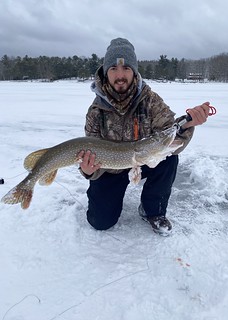
Trenten Friend caught this fine looking northern pike recently at Deep Creek Lake while using a live minnow. Photo courtesy of Trenten Friend.
Fishing for smallmouth bass and walleye in the upper Potomac River can be a worthwhile endeavor during the late winter months. It can require specialized gear and safety measures due to strong currents and cold water. Shoreline eddies adjacent to preferred mid-river habitats can be targeted using jigs moved slowly along the bottom. Population data suggests that this fishery has declined in recent years, which is largely due to springtime flooding events inhibiting reproduction. The department has created a supplemental stocking program to boost reproduction and has already documented a positive response in the fishery following the first year of this effort in 2020. Additional information regarding this management strategy can be found on our website.
Recent survey results suggest that the majority of walleye in the upper Potomac are within the 15-inch to 20-inch size range, which is largely due to excellent reproduction in 2019. A protective slot limit is in place from Jan. 1 to April 15, where fish larger than 20 inches must be released. This was enacted to protect the larger spawning females so that they may successfully contribute to the population. During winter months, walleye can be found taking refuge behind submerged ledges with moderate current. As river levels rise, which is quite common during winter into spring, walleye move toward shoreline eddies but still tend to prefer more current than other riverine fishes during the colder months. Typically, by late February into early March, walleye can be found more concentrated as they make their spawning upstream migration. During this time, upstream barriers such as dams support high densities of fish and anglers can find great success targeting these areas. Light tackle, such as jigs and live minnows, can be used to catch these finicky creatures.
An increasingly popular muskellunge fishery has captured the attention of river anglers. Muskellunge have earned the reputation as “the fish of 10,000 casts,” and pursuing them demands perseverance and dedication. This apex predator typically occupies defined winter habitats such as deep pools or “wintering holes,” and requires specialized tackle and gear. River conditions usually define an anglers approach; cold, low, and clear water normally requires a much more subtle presentation. Unlike their other cool water counterparts like walleye, muskellunge tend to avoid the current during winter months. Elevated flows push these fish into refuge areas with sufficient cover, where they can ambush their prey. As water temperatures warm and the fishes’ metabolic demand increases, larger lures seem to be preferred. Anglers are encouraged to equip themselves with the appropriate gear to target muskellunge. Because they are a long-lived, low density fish, angling-related mortality can have detrimental effects to this resource. DNR’s Maryland Muskellunge webpage provides handling tips, a direct link to our Voluntary Creel Diary Program, and additional information for anglers who wish to dive into the muskie world.
The pre-season trout stocking program is well underway and anglers have been able to enjoy the put-and-take areas and bring home some trout. The delayed harvest areas are also providing plenty of fun catch-and-release action. The stockings are posted after they occur so be sure to check out the trout stocking website for the latest stocking news or get instant notification by subscribing to our email service.
The winter months always provide some of the best chain pickerel fishing of the year. Aquatic vegetation is down, and chain pickerel do not mind cold water temperatures. They are ambush predators, so they will often be found near structure waiting for dinner to swim by them. Along shorelines they will be found holding near fallen tree limbs and logs, these are usually fish less than 24 inches in length. Larger chain pickerel will often be found in more open water and near structure such as tree stumps or sunken wood, which provide great ambush points. There is nothing subtle about the strike of a chain pickerel and they will often inhale baits, so treble hooks can cause damage to gill rakers and make unhooking difficult. Single hook baits such as paddle tails and spinnerbaits can be a good choice, and needle nose pliers can be a real asset when unhooking fish.
Largemouth bass are holding deep this time of the year, often in 15 feet to 20 feet of water near channel drop-offs and structure. Underspins rigged with a swimbait, silver buddies, small grubs, and soft plastic craws rigged with football, ball, mushroom, or flip’n type jig heads and deep suspended jerkbaits are all good choices. All should be worked slowly and close to the bottom, pickups will be very subtle. In farm ponds, wacky rigged plastic worms are a good tactic.
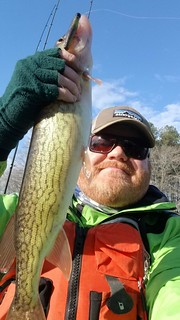
Photo by Eric Packard
Crappie can be found holding deep near structure such as bridge piers, marina docks and sunken brush. In some lakes such as Unicorn and St. Mary’s lakes, biologists have sunken old Christmas trees to provide structure to hold crappie for anglers. Small minnows and jigs rigged under slip bobbers is a great way to fish for them.
Atlantic Ocean and Coastal Bays
Fishing for tautog is at the top of the list for Ocean City anglers and will continue for several months. The boats that have been venturing out to the offshore wreck and reef sites are finding good fishing on most occasions. Tautog fishing is totally dependent on weather and sea conditions. Strong winds of course make for rough going in boats but they also stir up the waters below which can hamper fishing success.
The recreational sea bass season will not open until May 15 and then will continue to Dec. 31. The daily limit will be 15 sea bass per angler with a 12.5-inch minimum size. The recreational striped bass regulations for coastal waters has been set at one fish per day with a slot of 28 inches minimum and less than 35 inches. The mako shark regulations have also been set at 71 inches minimum for males and 83 inches for females. The flounder season is open all year; with the minimum size is 16.5 inches with a 4 fish per day creel limit. The bluefish daily angler limit will once again be 3 fish per day for private recreational boats and 5 fish per day when fishing on a charter boat.
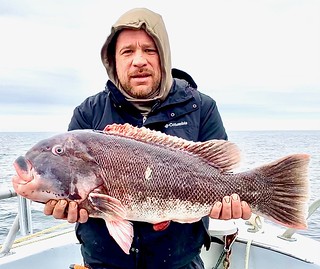
Monty Hawkins
“Listen to the voice of nature, for it holds treasures for you.” — Huron saying.
Maryland Fishing Report is written and compiled by Keith Lockwood, Maryland Department of Natural Resources fisheries biologist.
Josh Henesy, DNR fisheries biologist, provided the information on winter fishing for walleye, smallmouth bass and muskellunge on the upper Potomac River.
Click Before You Cast is written by Tidewater Ecosystem Assessment Director Tom Parham.
This report is now available on your Amazon Echo device — just ask Alexa to “open Maryland Fishing Report.”

If anyone has any doubts about the exploding populations of blue catfish in rivers such as the Patuxent, this picture of blue catfish brought to the surface by an electro-fishing survey is an eye opener. Photo by Mary Groves


John McMullen holds up a big Susquehanna River blue cat. Photo by John McMullen


Photo by Eric Packard

Trenten Friend caught this fine looking northern pike recently at Deep Creek Lake while using a live minnow. Photo courtesy of Trenten Friend.


